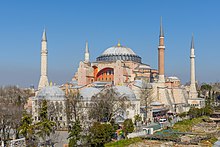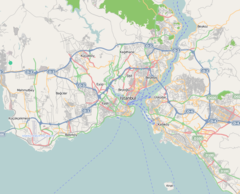Hagia Sophia Mosque

A view of Hagia Sophia, Istanbul
|
|
| Coordinates | 41°00′31″N 28°58′48″E / 41.0085°N 28.9799°ECoordinates: 41°00′31″N 28°58′48″E / 41.0085°N 28.9799°E |
|---|---|
| Location | Istanbul (historically Constantinople), Turkey |
| Designer |
Isidore of Miletus Anthemius of Tralles |
| Type |
|
| Material | Ashlar, brick |
| Length | 82 m (269 ft) |
| Width | 73 m (240 ft) |
| Height | 55 m (180 ft) |
| Beginning date | 532 |
| Completion date | 537 |
|
|
Hagia Sophia (/ˈhɑːɡiə soʊˈfiːə/; from the Greek: Αγία Σοφία, pronounced [aˈʝia soˈfia], "Holy Wisdom"; Latin: Sancta Sophia or Sancta Sapientia; Turkish: Ayasofya) was a Greek Orthodox Christian patriarchal basilica (church), later an imperial mosque, and is now a museum (Ayasofya Müzesi) in Istanbul, Turkey. The Roman Empire's first Christian Cathedral, from the date of its construction in 537 AD, and until 1453, it served as an Eastern Orthodox cathedral and seat of the Patriarch of Constantinople, except between 1204 and 1261, when it was converted by the Fourth Crusaders to a Roman Catholic cathedral under the Latin Empire. The building was later converted into an Ottoman mosque from 29 May 1453 until 1931. It was then secularized and opened as a museum on 1 February 1935. Famous in particular for its massive dome, it is considered the epitome of Byzantine architecture and is said to have "changed the history of architecture". It remained the world's largest cathedral for nearly a thousand years, until Seville Cathedral was completed in 1520.
...
Wikipedia

